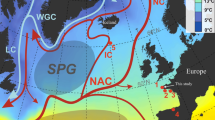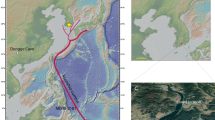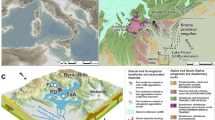Abstract
Vegetation dynamics during previous warm interglacial periods shed light on the human impacts on natural ecosystems during the Holocene. However, reliable terrestrial records that span such periods are rare and provide little information on regional scale. Here we present a high-resolution marine pollen record from the northern South China Sea, which reveals that during five peak interglacial periods, Marine Isotope Stages 13a, 11c, 9c, 5e and 1 (the Holocene), the vegetation successions in southern China were similar. At the beginning of each interglacial period, tropical rainforest conifers, which include Dacrydium, Dacrycarpus and Podocarpus, and associated broadleaved taxa, such as Altingia, expanded quickly at the expense of the subtropical/temperate montane conifer Pinus. Near the end of the warm periods, Pinus recovered and the tropical taxa retreated. However, the Holocene displays subtle but significant differences in which the species turnover was interrupted and the rainforest conifers did not fully expanded. The Mg/Ca-based sea surface temperature record from the same site reveals that temperature was the major control of the rise and fall of the peak interglacial vegetation. However, exceptionally high charcoal fluxes during the Holocene suggest that human activities through land-use modifications completely, and possibly permanently, altered the natural vegetation trend five to six thousand years ago.
This is a preview of subscription content, access via your institution
Access options
Access Nature and 54 other Nature Portfolio journals
Get Nature+, our best-value online-access subscription
$29.99 / 30 days
cancel any time
Subscribe to this journal
Receive 12 print issues and online access
$259.00 per year
only $21.58 per issue
Buy this article
- Purchase on Springer Link
- Instant access to full article PDF
Prices may be subject to local taxes which are calculated during checkout




Similar content being viewed by others
Data availability
The data that support the findings of this study are available from the corresponding author upon reasonable request.
References
Hays, J. D., Imbrie, J. & Shackleton, N. J. Variations in the earth’s orbit: pacemaker of the ice ages. Science 194, 1121–1132 (1976).
Past Interglacials Working Group of PAGES. Interglacials of the last 800,000 years. Rev. Geophys. 54, 162–219 (2016).
Steffen, W., Crutzen, P. J. & McNeill, J. R. The Anthropocene: are humans now overwhelming the great forces of nature? Ambio 36, 613–621 (2007).
Crutzen, P. J. Geology of mankind. Nature 415, 23 (2002).
Lewis, S. L. & Maslin, M. A. Defining the Anthropocene. Nature 519, 171–180 (2015).
Ellis, E. C. Anthropogenic transformation of the terrestrial biosphere. Phil. Trans. R. Soc. A 369, 1010–1035 (2011).
Ruddiman, W. F. The anthropogenic greenhouse era began thousands of years ago. Clim. Change 61, 261–293 (2003).
Ruddiman, W. F. The Anthropocene. Annu. Rev. Earth Planet. Sci. 41, 45–68 (2013).
Ruddiman, W. F., Ellis, E. C., Kaplan, J. O. & Fuller, D. Q. Defining the epoch we live in. Science 348, 38–39 (2015).
Cheddadi, R. et al. Similarity of vegetation dynamics during interglacial periods. Proc. Natl Acad. Sci. USA 102, 13939–13943 (2005).
Zohary, D. & Hopf, M. Domestication of Plants in the Old World (Oxford Univ. Press, Oxford, 1993).
Wang, P. X., Li, Q. Y. & Tian, J. Pleistocene paleoceanography of the South China Sea: progress over the past 20 years. Mar. Geol. 352, 381–396 (2014).
Sun, X. J., Li, X. & Beug, H. J. Pollen distribution in hemipelagic surface sediments of the South China Sea and its relation to modern vegetation distribution. Mar. Geol. 156, 211–226 (1999).
Dai, L., Weng, C. Y., Lu, J. & Mao, L. Pollen quantitative distribution in marine and fluvial surface sediments from the northern South China Sea: new insights into pollen transportation and deposition mechanisms. Quatern. Int. 325, 136–149 (2013).
Yu et al. A last glacial and deglacial pollen record from the northern South China Sea: new insights into coastal-shelf paleoenvironment. Quatern. Sci. Rev. 157, 114–128 (2017).
Wu, Z. Y. in Vegetation of China 823–896 (Science Press, Beijing, 1980).
Lüthi, D. et al. High-resolution carbon dioxide concentration record 650,000–800,000 years before present. Nature 453, 379–382 (2008).
Jouzel, J. et al. Orbital and millennial Antarctic climate variability over the last 800,000 years. Science 317, 793–796 (2007).
Williams, J. W., Shuman, B. N., Webb, T. III, Bartlein, P. J. & Leduc, P. L. Late-Quaternary vegetation dynamics in North America: scaling from taxa to biomes. Ecol. Monogr. 74, 309–334 (2004).
Reille, M. & Beaulieu, J. L. Long Pleistocene pollen records from the Praclaux crater, south-central France. Quatern. Res. 44, 205–215 (1995).
Willis, K. J. & Whittaker, R. J. The refugial debate. Science 287, 1406–1407 (2000).
Herbert, T. D., Peterson, L. C., Lawrence, K. T. & Liu, Z. H. Tropical ocean temperatures over the past 3.5 million years. Science 328, 1530–1534 (2010).
Li, L. et al. A 4-Ma record of thermal evolution in the tropical western Pacific and its implications on climate change. Earth Planet. Sci. Lett. 309, 10–20 (2011).
Cheng, H. et al. The Asian monsoon over the past 640,000 years and ice age terminations. Nature 534, 640–646 (2016).
Guo, Z. T., Berger, A., Yin, Q. Z. & Qin, L. Strong asymmetry of hemispheric climates during MIS-13 inferred from correlating China loess and Antarctica ice records. Clim. Past 5, 21–31 (2009).
Xiao, J. Y., Lu, H. B., Zhou, W. J., Zhao, Z. J. & Hao, R. H. Evolution of vegetation and climate since the last glacial maximum recorded at Dahu peat site, South China. Sci. China Earth Sci. 50, 1209–1217 (2007).
Sheng, M. et al. A 20,000-year high-resolution pollen record from Huguangyan Maar Lake in tropical–subtropical south China. Palaeogeogr. Palaeoclimatol. Palaeoecol. 472, 83–92 (2017).
Zhang, C. & Hung, H. C. Later hunter–gatherers in southern China, 18000–3000 bc. Antiquity 84, 11–29 (2012).
Zhang, C. & Hung, H. C. The Neolithic of southern China—origin, development and dispersal. Asian Perspect. 47, 299–329 (2008).
Zhao, Z. J. New archaeobotanic data for the study of the origins of agriculture in China. Curr. Anthropol. 52, 295–306 (2011).
Zhang, C. & Hung, H. C. The emergence of agriculture in southern China. Antiquity 84, 11–25 (2010).
He, K. Y., Lu, H. Y., Zhang, J. P., Wang, C. & Huan, X. J. Prehistoric evolution of the dualistic structure mixed rice and millet farming in China. Holocene 27, 1885–1898 (2017).
Lu, H. Y. New methods and progress in research on the origins and evolution of prehistoric agriculture in China. Sci. China Earth Sci. 60, 2141–2159 (2017).
Yang, S. X. et al. Modern pollen assemblages from cultivated rice fields and rice pollen morphology: application to a study of ancient land use and agriculture in the Pearl River Delta, China. Holocene 22, 1393–1404 (2012).
Clark, J. S. et al. Reid’s paradox of rapid plant migration. Bioscience 48, 13–24 (1998).
Russell, A. E., Raich, J. W. & Vitousek, P. M. The ecology of the climbing fern Dicranopteris linearis on windward Mauna Loa, Hawaii. J. Ecol. 86, 765–779 (1998).
Marks, R. Tigers, Rice, Silk, and Silt: Environment and Economy in Late Imperial South China (Cambridge Univ. Press, Cambridge, 2006).
Mohtadi, M. & Cruise Participants. Report and Preliminary Results of RV Sonne Cruise SO 221. INVERS. Hongkong—Hongkong, 17.05.2012–07.06.2012 (Berichte, Fachbereich Geowissenschaften 288, Universität Bremen, 2012).
Blaauw, M. & Christen, J. A. Flexible paleoclimate age–depth models using an autoregressive gamma process. Bayesian Anal. 6, 457–474 (2011).
Lisiecki, L. E. & Raymo, M. E. A Plio-Pleistocene stack of 57 globally distributed benthic δ18O records. Paleoceanography 20, PA1003 (2005).
Liu, J. G. et al. Temporal and spatial patterns of sediment deposition in the northern South China Sea over the last 50,000 years. Palaeogeogr. Palaeoclimatol. Palaeoecol. 465, 212–224 (2017).
Martínez-Méndez, G. et al. Changes in the advection of Antarctic intermediate water to the northern Chilean coast during the last 970 kyr. Paleoceanography 28, 607–618 (2013).
Shackleton, N. J. & Opdyke, N. D. Oxygen isotope and paleomagnetic stratigraphy of equatorial Pacific core V28-238: oxygen isotope temperatures and ice volumes on a 106 yr scale. Quat. Res. 3, 39–55 (1973).
Barker, S., Greaves, M. & Elderfield, H. A study of cleaning procedures used for foraminiferal Mg/Ca paleothermometry. Geochem. Geophys. Geosyst. 4, 8407 (2003).
Greaves, M. et al. Interlaboratory comparison study of calibration standards for foraminiferal Mg/Ca thermometry. Geochem. Geophys. Geosyst. 9, Q08010 (2008).
Anand, P., Elderfield, H. & Conte, M. H. Calibration of Mg/Ca thermometry in planktonic foraminifera from a sediment trap series. Paleoceanography 18, 887–895 (2003).
Mohtadi, M. et al. North Atlantic forcing of tropical Indian Ocean climate. Nature 509, 76–80 (2014).
Acknowledgements
We thank H. W. Dang, H. M. Ge, J. W. Wu, J. J. Liu and Y. R. Chen for their kind help in the laboratory work. This work was supported by the National Natural Science Foundation of China (NSFC, Grants 91128211, 91028010, 41877429, 40771072 and 41023004) and the German Ministry for Education and Research (BMBF, Grants INVERS 03G0221A and CARIMA 03G0806B).
Author information
Authors and Affiliations
Contributions
C.W., M.M. and S.S. designed the research. S.S. and M.M. measured the isotope and Mg/Ca ratios of the foraminifera and constructed the age model. Z.C. generated and analysed the pollen data. Z.C., C.W. and S.S. wrote the manuscript. M.M. reviewed the manuscript.
Corresponding author
Ethics declarations
Competing interests
The authors declare that they have no competing interests.
Additional information
Publisher’s note: Springer Nature remains neutral with regard to jurisdictional claims in published maps and institutional affiliations.
Supplementary information
Supplementary Information
Supplementary Description, Supplementary Figures 1–5 and Supplementary Tables 1 and 2.
Rights and permissions
About this article
Cite this article
Cheng, Z., Weng, C., Steinke, S. et al. Anthropogenic modification of vegetated landscapes in southern China from 6,000 years ago. Nature Geosci 11, 939–943 (2018). https://doi.org/10.1038/s41561-018-0250-1
Received:
Accepted:
Published:
Issue Date:
DOI: https://doi.org/10.1038/s41561-018-0250-1
This article is cited by
-
Prehistoric firewood gathering on the northeast Tibetan plateau: environmental and cultural determinism
Vegetation History and Archaeobotany (2022)
-
Detecting anthropogenic impact on forest succession from the perspective of wood exploitation on the northeast Tibetan Plateau during the late prehistoric period
Science China Earth Sciences (2022)



